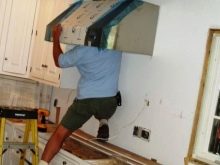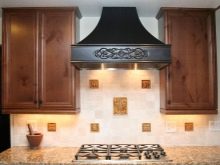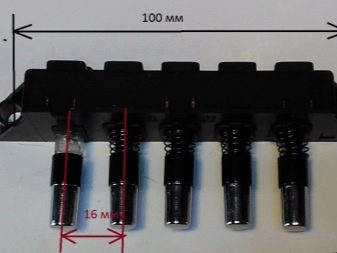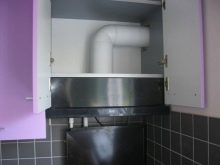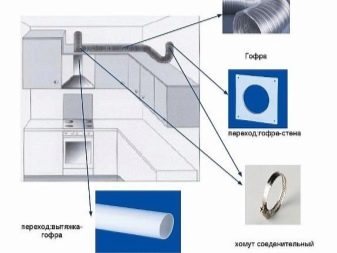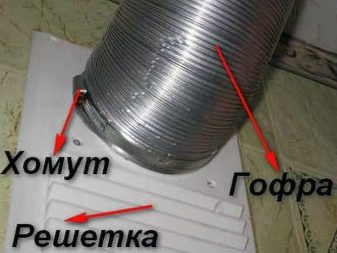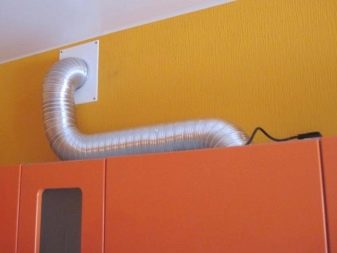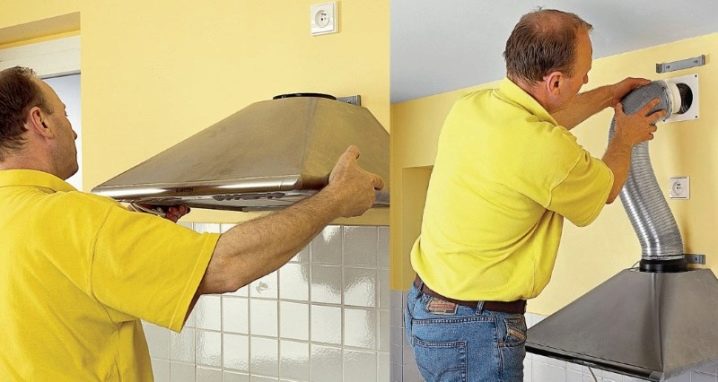How to install the hood in the kitchen?
During cooking, it is required to ensure high-quality circulation of air masses in order to remove various smells from the kitchen, as well as to reduce the temperature in this room. To ensure this effect is not enough only natural ventilation system. For this reason, a special device is placed above the stove that provides forced ventilation of the air - a kitchen hood. In this article we will explain how to install it correctly and make its work effective.
Types of devices
Installation of different models of hoods may vary depending on the features of their design and their category.
If we take as a criterion the method of air purification, then these devices can be as follows.
- Recycled. Such models are equipped with special filters that use coal. When passing through it, the air is cleaned and returned to the kitchen. The disadvantage of this option is the need to constantly replace the carbon cartridges, because you can not wash them. Usually such a device has flat models of the devices in question.
- With flow-through cleaning mechanism. These models perfectly clean air masses from soot and fumes of an oily nature, which is very often observed in the kitchen. Usually, these hoods are connected directly to the ventilation shaft. In order for such an extract to be as efficient as possible, its dimensions must be either the same as that of the stove or the cooking surface, or more. Such mechanisms are equipped with noisy, albeit powerful fans.
Any hood will be equipped with a filter, but it can be coal or it can consist of metal grates that are easy to clean. In flow models, such filters protect the ventilation shaft from the ingress of particles of fat.
Hoods may differ from one another and according to the method of attachment.
- Corner. Such models will be relevant if the stove is in the corner of the kitchen.Corner models can have both flow and recirculation systems. In accordance with this situation it is necessary to provide unhindered access to communications during installation - the ventilation shaft and electrical wiring.
- Embedded. These models are very compact and almost invisible in the kitchen, as they are usually mounted in a niche specially reserved for them. They require direct connection to the ventilation system. This gives them the opportunity to demonstrate the highest efficiency. Here, metal gratings are used as a filter, for which reason they should be cleaned regularly. They can be washed in the dishwasher.
This option looks quite aesthetically pleasing and can fit into almost any design concept, be it a modern loft or good old classics.
- Flat. They are installed when there is no access to the ventilation shaft for any reason. This device is completely self-sufficient, although it operates from the mains. It is usually equipped with a medium power fan. The cost of such an exhaust is small, but here you will often need to change the carbon filters.
- Island These models take up a lot of space, because they are attached to the ceiling directly above the stove. They usually install a powerful fan, which makes it possible to perfectly cope with cleaning. These hoods are often installed in the middle of the kitchen, just above the work area. Island solutions have a high price and nice design.
- Dome or fireplace. This type of exhaust system belongs to the group of high-power devices that have great functionality. Usually fixed on the wall above the stove, taking up a lot of space. Such models do not need replacement of filters.
It should be noted that when choosing a particular model, great attention should be paid to its height. During installation, it should be placed above the gas surface at a distance of 70-85 centimeters, and above the electric - from 60 to 85 centimeters.
The selection of a particular model will be carried out depending on the type of kitchen, furniture located in it, area of the room and features of the ventilation system.
Power requirement
When choosing this type of equipment, an important criterion that has a serious impact is the air purification capacity, which is measured in cubic meters.This value determines how much air masses the type of equipment in question can pass through itself in one hour of work.
If we talk about domestic standards, the air in the kitchen room within an hour should be updated completely 12 times. And if you need to calculate the power, this can be done using a simple formula - the height of the ceilings will need to be multiplied by the area of the kitchen room and the resulting number multiplied by 12.
When conducting calculations, it is necessary to make a small margin on the power drop due to the presence of various air ducts, the length of the ventilation shaft and other characteristics. To do this, to the result that was obtained, you should add 30%.
By the way, when acquiring a hood, you should take into account the noise it produces. Usually, manufacturers specify its level in decibels. You should not buy models that emit noise more than 50 decibels. Today there are on the market almost silent models with several fans with a special case that absorbs sound.
A large number of low-cost installations of built-in type is small in size, but this advantage can be a problem in terms of insufficient power of the air pump.This problem can be eliminated with a small refinement that can be easily performed by hand.
The point is to mount an additional duct-type fan in any part of the duct of an exhaust type. To implement this venture will require only a couple of adapters. It is necessary to lay the power supply cord of the fan either in parallel with the channel or in itself.
The installation can also be carried out in order to increase the power, taking into account that a regular fan and an additional channel fan are working. If desired, it is possible to carry out the replacement of the embedded solution with the model of the external type with a power gain of two to three times greater than the standard performance of the fans. It is clear that no one will complete an inexpensive system with too powerful a fan.
It must be remembered that the switch, which is equipped with hoods that can work in different modes, may not be designed to connect another fan, in addition to the standard one. Then it is better not to try to understand the essence of the device of such a switch, but simply to install an additional toggle switch of the body type.To do this, you just need to drill another hole in any convenient part of the device and install the switch and connect it.
Requirements
If we talk about the design of the cabinet under the hood built-in character, it is quite simple. In such a cabinet there are two walls on each side with a total depth of the upper tier, which are fastened with a horizontal partition on top and without bottom. There should be an inner shelf, located between the walls. It is better not to order an additive of such a part during creation: four confirmant can be installed on your own, but the extractor will be placed as closely as possible.
With the requirements in size everything will be more difficult. In order to fit organically into the furniture structure after installation, without creating any cracks and holes, the hood or its drawing with the main dimensions should already be in the possession of the owner before creating the furniture. And the dimensions of the device should be selected taking into account the width of the panel for cooking or stove, as well as the moment that the body will actually be two to three centimeters more.
The lower part will be the widest, so it is from it that the basic dimensions of the cabinet will be determined.Its size outside should have the same width as the hood itself. If we talk about the furniture case, then its depth can be more by 5-6 centimeters. Then the hood can be moved to the front wall, and just open the open part with a small partition for fastening.
It should be remembered that the body of the hidden part of the hood will have a gap of 1-1.5 centimeters from the cabinet wall. This condition can not be neglected in any case, since this is one of the most important conditions for the installation of embedded electrical equipment.
With the height of the cabinet, everything is more or less clear, since usually the distance between the bottom of the upper tier and the table top is from half a meter to 65 centimeters. As mentioned above, the distance between the gas stove and the device should be from 70 to 85 centimeters, and the hood and electric range - 60-85 centimeters. That is, the section where the hood is mounted will significantly fall out of the general kitchen ensemble. The height of the cabinet in this case may be 8-12 less than other cabinets.
Assembly work
Installation of the hood in the kitchen is usually divided into several stages.
- First you need to mount the hood in the required place on the wall. This implies that it will have to hang over the stove, fastened to the wall or to the ceiling.
- The device is connected to the mains.
- Connecting the duct and its removal into the ventilation channel.
Let's start with the dome hood. Devices of this type are equipped with a flow-through filtration mechanism and require direct connection to the ventilation shaft. To ensure the operation of the fan, it is necessary that the socket is located nearby. Before assembling the device, it is necessary to fully assemble the kitchen unit. It will not be superfluous to apply the markup, taking into account the dimensions of the selected model hoods. It should be fixed to the wall as firmly as possible. For this reason, holes are first punched under exhaust fixtures using a drill or a perforator, if the wall is made of concrete or brick. It is necessary to mount the dowels in these holes and to fasten special fastenings with bolts, which are usually supplied in the kit.
If we are talking about the built-in hood, it will be almost invisible in the kitchen. Typically, this type is installed either in a special panel that extends, or in a special box that is mounted.If it is necessary to make a cabinet installation, then it should be understood that it should be made strictly according to the dimensions of the device. It is possible to learn its characteristics according to information which will be contained in the instruction to the equipment.
Given that this type of hood is built in, its lower part should be flush with the cabinet. For this reason, the bottom rises to the height of the device, and then screwed to it. The mass of this design will be impressive, for which reason all components must be installed correctly. The bottom is best fixed using eurobolts.
Note that the cabinet will close the air duct. It is necessary to make a hole for the corrugated pipe. If the ventilation shaft is located in the wall behind the cabinet, which is often the case in private homes, then the back wall should also be cut out. If we are talking about an apartment, then the channel will be located near the ceiling, for which reason the upper part should be cut out. The cabinet is placed on the floor or on its side and an exhaust hood is attached to it. Now everything is put in place and firmly attached with bolts. But bolts alone will not be enough for the reason that the mass of the structure will be too large.To strengthen the wall, you must first attach a special metal profile designed specifically for wall-mounted cabinets, and the construction is attached to it from the side.
Now it is necessary to attach a pipe made of corrugations to the ventilation mechanism and hood. The hood is connected to the power grid and a test of its operability is carried out. Now you just need to fix the facade of the cabinet, after which the work will be completed.
If it is necessary to install a flat extractor of recirculation type, then it should be said that this is a suspended type construction that hangs over the stove or hob. There is a recirculation cleaning system installed and there is no duct, due to which the whole structure is flat.
To make the installation of this model more simple, you should follow these rules.
- On the case of the device there are special holes to fix it to the wall. Under them, using a perforator in the wall, holes are punched into which the so-called dowel nails are inserted.
- Attached to them canopies, which are usually supplied with the device in the kit. The hood is attached to them.
- Now you just need to connect to the network and you can use the device.
In general, as you can see, the installation scheme of different models of hoods will be about the same. Even if you have a homemade hood, it will be installed by the same procedure.
Electrical connection
Due to the accumulation of steam and fatty deposits inside such equipment, it is likely to receive an electric shock if the connection was made incorrectly. In order to connect an exhaust device in the kitchen and supply electricity to it, there must be three cables - phase, zero and earth. Holding the land according to the standards should be yellow, divided by a green stripe. And before starting installation work, you should make sure that there is a ground connection.
Of course, if the kitchen already has a ground cable and European standard sockets are mounted, then it greatly simplifies the connection: it is enough to connect the wire to the ground contact, which usually has the designation in the form of strips of various lengths or the letter abbreviation GND. If the device does not provide for grounding, and such models are found on the market, it is better to do it yourself, simply by connecting the cable to the body of metal.
If grounding is not provided in the sockets, then it is necessary to carry it out with your own hands. But if you do not know how you can do it yourself, then it is better to resort to the services of an appropriate specialist. And do not try to connect the neutral wire to the pipes or the battery. It must be fixed exclusively on a deaf neutral.
We should not forget that the hood must be included in a separate outlet, which is mounted at the level of the exhaust hood of the entire mechanism or slightly higher.
During the construction of any room that will be used for human habitation, a ventilation system is also made. When you or the specialist you call connects the kitchen hood, its operation is disrupted. To reduce these violations to a minimum, it is necessary to carry out the installation of an additional box equipped with a special valve. Its principle of operation is extremely simple: when the hood is turned off, the valve is closed with a lid, and the air goes out independently. When cooking is going on and the hood is activated, the valve with a pressure force of air from the fan blocks the hole of natural ventilation.Such a mechanism has advantages - no reverse thrust.
Now let's proceed directly to the description of the process of connecting the exhaust device to the electrical network.
When the design has been fully installed, it is necessary to mount the outlet, if it is not already in the right place. A separate line should be drawn from the transfer case. It would be nice if it is located on a wall located in the corridor. Then it will only be necessary to make a hole in the wall, pull the wires out and attach the socket in a place convenient for you.
If the razdatkorobka located at a considerable distance or in an uncomfortable place, then the work will be pretty serious. First you need to pierce the walls, lay the wires, and then make the connection to the switchboard. But everything will depend on each specific case.
Installation of the ventilation duct
There are two main categories of air ducts for exhaust devices.
- Aluminum corrugated. They bend well, stretch and they can be adjusted to one or another size. This version of the duct does not create noise and vibration, but from an aesthetic point of view it can not be called beautiful.Usually he hides in a closet, box or inside a suspended ceiling.
- Air ducts made of polyvinyl chloride or plastic. This material weighs a little and is considered quite durable. Due to the presence of a smooth coating, the air flow during movement does not form any noise.
Before installing the air duct in the kitchen, make sure that the only standard vent in the room is not blocked by a pipe. If it is only one, then another exit from the shaft often breaks through and a check valve is mounted that will block the flow when the device is activated. You can also use a special box with a flapper type valve.
We now turn directly to the installation of the duct. At first it is necessary to push the corrugation into the holes made, and in the upper wall of the cabinet it is necessary to give it the necessary, as a rule, square shape. Now you need to cut the corrugation with a small margin, as well as make cuts in the corners to bend them out.
It is necessary to hang a wardrobe with corrugation on the wall. Before this, you should not forget about the processing of all airway joints with silicone-based sealant.It is necessary that the design was tight and there was no power loss. In the next step, you need to fix the homemade box on the cabinet, which will allow to connect the corrugated material with the ventilation shaft. It also will not be superfluous to put on silicone.
If the gaps are too large, then it is better not to try to seal them with silicone. Then you need to use mounting foam.
Now fix the hood in the closet. It is better to fasten it on the screws or dowels. The second option will be relevant if the mount is intended for the wall.
Firmly attach the corrugation to the exhaust device and carry out the fixation using a clamp. It is not necessary to lubricate the compound with a sealant.
If the exhaust device is connected directly to the ventilation, then it is sufficient to simply connect the duct directly to the ventilation shaft. For the implementation of their convenient joining, you can use a special grid in which there is a round hole.
If we are talking about the installation of polyvinyl chloride air ducts, the installation will be the same: we simply connect the pipes to the corners and complete them before ventilation.
At installation of ventilation it is necessary to reduce as much as possible the number of pipe bends. This will save a good air draft in the pipe. Each tubular twist reduces power by about ten percent.
Useful tips and common mistakes
Corrugation will be more interesting and effective material for creating a ventilation duct for a number of reasons. For example, it does its job better than plastic pipes. Its installation will cost significantly less than other materials. She also has no loss of efficiency, which is not the case with plastic duct pipes. When installing it can be quite stretch, which will significantly reduce the noise level during operation of the system.
Another useful tip is that plastic pipes and corrugations should be cleaned at least a couple of times a year in order to prevent them from clogging with some specific accumulations and wastes.
You should also not hesitate to consult with experts in exhaust systems, if you want to carry out an independent installation. It will be good if you have an assistant who has already encountered some problems in creating a ventilation system - then you will have someone to discuss this or that problem.
Hoods are usually equipped with special odor neutralizers, which can be:
- ultraviolet;
- based on chemistry;
- electroionization.
Chemical solutions require constant replacement, as their active element is delayed by a fatty film. This option can also be dangerous to human health. Electric ionization solutions work in the same way as a conventional air ionizer. This option has a disadvantage, since it will be located close to the person who is at the stove - this puts the safety at risk.
Ultraviolet solutions require periodic cleaning of lamps from burning and fatty deposits. Lamps need to be changed once a couple of years. But this option will be completely safe and harmless, since the ultraviolet radiation here is at a very low level.
By the way, the use of such a solution can resolve the issue and the lighting of the stove or hob, since besides the radiation mentioned, llamas emit a barely noticeable bluish or white color.
It should be remembered that each stage of the installation is important and its role can not be overestimated due to the factthat it is necessary to make the slightest mistake or deviation in the process of horizontal installation of the hood, and this in almost 100% of cases will lead to problems in the future, which at first may seem unnoticeable. For example, if you applied a small amount of sealant or left a gap that is not visible. This will definitely affect the work of the whole mechanism.
The most common mistakes made by builders are the following.
- In the ventilation chamber, the pipe is bricked, and the exhaust device, where the check valve is installed, is directly connected to it. If the hood is not functioning, then the ventilation of the room becomes impossible due to the fact that the valve simply closes the pipe when the fan is inactive.
- When installing often use a pipe whose diameter is 100 millimeters. This is not enough. It is necessary for ventilation to use a tube of 125-millimeter diameter. The pipe with the specified diameter removes polluted air masses up to 350 cubic meters in one hour.
In general, it is relatively easy to eliminate these two errors - it is enough just to expand the entrance to the cooling tower, and also to mount the special grid for the exhaust mechanism.
The process of installing the hood in the kitchen is fraught with certain difficulties that a person who does not have certain knowledge cannot always eliminate. That is why it would not be superfluous to self-install the hood in the kitchen to attract a specialist or at least consult him.
How to install the hood in the kitchen, see the following video.

